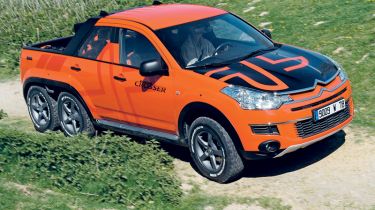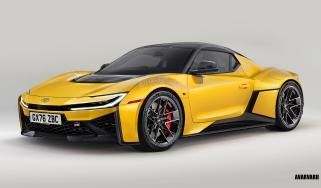Citroen Cruise Crosser
The Cruise Crosser is a sensible first attempt at a pick-up truck, and proves Citroen is serious about joining the market
The Cruise Crosser is a sensible first attempt at a pick-up truck, and proves Citroen is serious about joining the booming market at some point in the future. Considering the criticism large 4x4s come in for, it makes perfect sense to use diesel-electric hybrid power. Having folding seats in the load bed is also a great idea that would certainly appeal to customers increasingly turning to pick-ups as practical leisure vehicles.
When it comes to standing out on Britain's roads, a 4x4 just isn't enough - these days, you need a 6x6!
To prove it, we have tried out Citroen's amazing six-wheel-drive Cruise Crosser, a machine which is firmly aimed at propelling the French manufacturer all the way to the top of the pick-up crop.
When it made its world debut at the Geneva Motor Show in March, the dramatic all-terrain concept car wowed the crowds with its innovative multi-wheeled design. Inspired by the growing market for leisure pick-ups - which is currently dominated by the Mitsubishi L200 and Nissan Navara - the newcomer has been designed to show how a Citroen truck of the future could look.
Beneath the eye-catching orange paintjob, the Cruise Crosser is 90 per cent standard C-Crosser - that's the company's new SUV, which is scheduled to arrive in showrooms here in the summer. The remaining 10 per cent starts where the roof ends!
Although there's a third row of wheels, this is nothing more complicated than a second suspension unit bolted on to an extended rear overhang. But rather than powering these additional wheels with the 2.2-litre turbodiesel engine under the bonnet, Citroen has chosen to install a 20kW electric motor. Along with its batteries, this is positioned beneath the load bed floor, and the driver can engage it simply by pressing a button mounted on the dashboard. Doing so transforms the Cruise Crosser from four to six-wheel drive.
With power being transmitted to all six wheels, you would expect the newcomer to be a heavy, lumbering machine. The reality is that you don't notice any difference in manoeuvrability over a regular off-roader - and of course, that extra pair of wheels yields a phenomenal amount of grip from the rear over loose surfaces. On the tarmac, the 2.2-litre engine has plenty of urge, and when the model is operating as a hybrid, it has a very respectable total output of 186bhp.
However, it's passengers in the third row of seats who really get to benefit from this car. Citroen bosses describe the forthcoming C-Crosser as a five-plus-two-seater, as the extra pair of fold-away chairs right at the back offers such limited space, it really is suitable only for children. However, in the Cruise Crosser, more people will be encouraged to use them as they are out in the open.
And thanks to the new machine's aerodynamics, you can happily sit in the sun without being blown about at speed. The downside is that the company's engineers haven't yet come up with a reliable way of sealing the interior. So if you plan to head off-road, dust will become a regular feature inside as well as out.
Nevertheless, the twin instrument binnacles give the cockpit quite a sporty look. What's more, it's made from high-quality soft-touch plastic and feels well screwed together.
Meanwhile, the seats are trimmed in black leather, and with orange cloth inserts they're unique to this car. The weave of the material is said to be inspired by a metal watch strap.
At the same time, the wire running around the edge of the chairs doubles as a useful grab handle, and you can even hang items such as road atlases on it. It gives the Cruise Crosser a utilitarian feel - and suggests that it won't be long before the Japanese firms which dominate the pick-up market will face some stiff competition from Europe.







